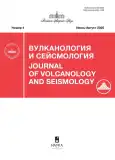No 4 (2025)
Articles
Magmatic activity of Mutnovsky volcano and crater formation at the site of blowing well 022
Abstract
Mutnovsky volcano in the last four thousand years is characterized by predominantly magmatic activity in the northern sector, where the Mutnovsky geothermal field was formed. Magmatic activity is detected by the Frac-Digger method using seismic data of KF FIC EGS RAS, the most powerful sequence of shallow dykes of NE strike is manifested at the surface by blowing geothermal wells. Dyke emplacement in March 2024 is synchronized with a hydrothermal explosion with the formation of a crater with a volume of up to 0.36 million m3 at the site of well 022 (Crater 022+). Unaltered debris from the explosion indicates lithoclastic character in the head gas-saturated part of the dyke. The base of the explosion crater is a hydrothermally altered (opal, zeolites) plane of 160×75 m2. The mechanism of the hydrothermal explosion is considered as a result of hydraulic fracturing of the two-phase geothermal reservoir by a shallow dyke, with subsequent pressure increase in the shallow hydrothermal reservoir near the well with a closed wellhead valve.
 3-21
3-21


Phase and chemical composition of high-temperature sublimates of Avachinsky volcano (Kamchatka)
Abstract
This work presents results of studying sublimates (mineral phases deposited from volcanic gases) that were collected in silica glass tubes placed in high-temperature fumaroles at the Eastern fumarole field of Avachinsky volcano (Kamchatka) in 2013–2023. The concentration distributions of 62 elements along the length of the tubes (along the temperature gradient) were studied by ICP-MS and ICP-AES methods. 35 phases of sublimates corresponding to natural minerals and 7 phases of sublimates for which no natural analogues are known were diagnosed. A general mineral sequence with decreasing temperature is as follows: Na and K halides; Na, K, Ca sulfates; sulfides; X-ray amorphous As-S glass and Tl, Pb, Bi halides. The most common phases are As-S glass, SiO2, NaCl, KCl, Na2SO4‒K2SO4; rare phases are KCdCl3, K2Pb(SO4)2, Tl(I,Cl,Br), Pb2Tl(Cl,I,Br)5, PbTl3(Cl,I,Br)5, Pb(Cl,I,Br)2, Tl3BiI6, ReS2, Pb-Zn-Cd-In sulfides and AgI.
 22-41
22-41


Pliocene-Quaternary Volcanism in the Interfluve of the Kozyrevka and Malaya Romanovka Rivers (Sredinny Range of Kamchatka): Age and Composition of the Rocks
Abstract
 42-59
42-59


TTEPHRA FROM LACUSTRINE SEDIMENTS OF THE MAGADAN REGION
Abstract
 60-83
60-83


Gabbro of the Esmeralda underwater volcano(Mariana Island Arc)
Abstract
 84-100
84-100


Upgrading the Sensitivity of the Seismological Network in the Lena River Delta Area
Abstract
 101-112
101-112












